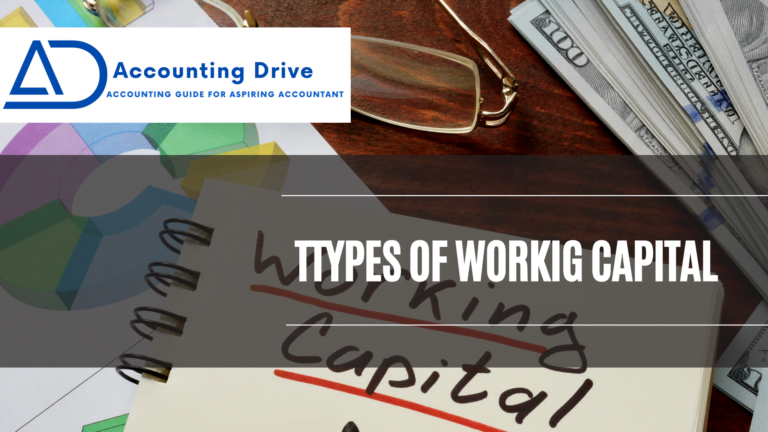Looking puzzled! Why there are too many different types of working capital? why they are categorized so broadly? & most importantly why is working capital so important for any business or company? Working capital is the lifeblood of any business because a business can survive even in losses (without having any profit) but maintaining liquidity is compulsory. The article aims to provide you with a better-detailed understanding of different types of working capital, the basis of their division, and what makes them different from each other.
Be energetic & understand with me.
What is Working Capital?
In This Article
ToggleShortly let’s first discuss what is working capital? It is the amount that a company requires to finance its day-to-day operations and expenses.

- It represents the liquidity position of a company or it’s simply the difference between current assets and current liabilities.
What is Working Capital Formula?
Working Capital Formula
It represents the liquidity position of a company or it's simply the difference between current assets and current liabilities.
What are the Main Types of Working Capital?
Let’s dive straight into the main topic.
Working capital represents the liquidity position of the company. For maintaining your liquidity position, you require proper working capital management. Thus, at this stage, you should be able to understand the different types of working capital and on what basis they are categorized and calculated. However, types of Working capital are broadly categorized into two fundamental bases or views- Periodicity and value.
On the basis of Value
Value is the balance sheet view of working capital, moreover, it divides working capital into gross and net working capital.
1. Gross Working Capital
Gross working capital shows the total invested amount in your company’s current assets. While current assets are those assets that can easily convert into cash within the period of 12 months. So, as it only indicates the amount of total current assets, one cannot get a clear picture of the company’s liquidity position.
Example: Gross working capital doesn’t keep in view the current liabilities of a company. For instance, a company’s total current assets amount to $500, and it has current debt amounted to $00. The amount of $500 is gross working capital.
2. Net Working Capital
Net working capital simply is the difference between your current assets minus current liabilities. It shows the liquidity position of a company- whether your company is financially sound enough to meet its current obligations or not? Therefore, it can be negative or positive.
- If the current assets exceed from current liabilities, then it shows a positive net working capital.
- If your current liabilities exceed your current assets, then it represents a negative balance- negative working capital.
- Net working capital becomes neutral or provides zero balance when current assets are equal to its current liabilities.
Is negative working capital always considered bad for a company? For more information, continue reading @ 𝐍𝐞𝐠𝐚𝐭𝐢𝐯𝐞 𝐖𝐨𝐫𝐤𝐢𝐧𝐠 𝐂𝐚𝐩𝐢𝐭𝐚𝐥 𝐨𝐫 𝐏𝐨𝐬𝐢𝐭𝐢𝐯𝐞 𝐖𝐨𝐫𝐤𝐢𝐧𝐠 𝐂𝐚𝐩𝐢𝐭𝐚𝐥: 𝐖𝐡𝐢𝐜𝐡 𝐢𝐬 𝐁𝐞𝐭𝐭𝐞𝐫?
Example: By continuing the same example discussed in gross working capital where a company’s total current assets amount to $500 and total current debt amount to $100. So, the amount of $500 is gross working capital and after a deduction of $100, we get $400 which is what we call net working capital.
Difference between Gross Working Capital and Net Working Capital
| Gross Working Capital | Net Working Capital | |
| Definition | Value of all current assets | Difference between current assets and current liabilities |
| Formula | Add all current assets | Current assets – current liabilities |
| Financial position | illustrate accurate liquidity position | Fails to represent an accurate liquidity position |
On the Basis of Periodicity
1. Permanent Working Capital
Permanent working capital is also termed fixed working capital. As the name suggests, it is the must required fixed minimum investment or current assets that a company needs annually to operate its business. However, the amount of fixed working capital depends on the size of the firm, the larger the firm size, the greater the amount will require to run its business operations.
Permanent working capital is further categorized into two types:
- Regular WC: It is the must-needed working capital amount to cover current working expenses and carry out day-to-day business operations under normal conditions.
Example: Overhead cost, wages, salary payments, and supplies and raw material purchase.
- Reserve WC: A business may face some uncertain situations as well as carry some risk factors, in order to offset and managing these risks and unforeseen situations, companies make a separate pool of funds or make contingencies. This additional amount is the reserve working capital.
Example: Natural calamities, strikes, inflation, or Sevier economic conditions.
2. Temporary Working Capital
Temporary working capital is also termed fluctuating or variable working capital. Here, you can see as the name suggest, it is the additional working capital required to meet the additional cash requirement during the annual period. There are certain business conditions where you need additional working capital. While additional cash requirements may include the increase in sales volume or the production of a new product line to satisfy seasonal demand.
Temporary working capital is further categorized into two types:
- Seasonal WC: Seasonal working capital is the additional cash that a company needs to meet its changing seasonal demands.
Example: Let’s say a clothing business possibly have to face two different season- the winter and the summer. During summer, people prefer to use cotton clothes. But they need woolen dresses in winter. So, to satisfy the needs of both seasons, the company will require a separate pool of temporary working capital for each season.
- Special WC: Similarly, special working capital is the additional cash required by the company to finance its certain events, activities, or business development programs.
Example: Introducing a new product line, advertising campaign, diversifying in different markets, expansion plans, or marketing research.
Difference between Permanent Working Capital and Temporary Working Capital
| Permanent Working Capital | Temporary Working Capital | |
| Definition | The fixed minimum amount is required by the company annually. | The additional cash is required by the company annually. |
| Dependence | Depending on the size of the firm- the larger company requires maintaining a higher level of current assets. | Depending on the seasonal and temporary needs of the company. |
| Nature | It is a fixed amount- stable. | It is above the permanent working capital amount- fluctuating in nature. |
Example: Company ABC requires $25,000 annually to run its operations. Here, this $25,000 amount is its permanent working capital which a company needs each year- the same amount. However, if a company wants to increase its sales volume by hoping to receive a heavy order in the next year. So, next year, its permanent working capital will remain the same at $25,000, and for increased future demand, the company will require additional cash in its working capital let’s say $5,000. Then, this additional $5,000 is considered its temporary working capital.
Key Points
- Working capital is the amount that a company requires to run its day-to-day business operations.
- Working capital is broadly divided into two main views- the balance sheet view and the operating cycle view.
- The value of all current assets a company has is considered gross working capital while net working capital is actually the difference between current assets and current liabilities.
- Permanent working capital is the required fixed annual investments in current assets.
- Temporary working capital is the additional cash- over the permanent capital a company requires to fulfill its seasonal demands and special events’ cash requirement.
Recommended Articles
Get Free access to the AD's working capital cheat sheet
Grab your cheat sheet now by clicking the button !!

